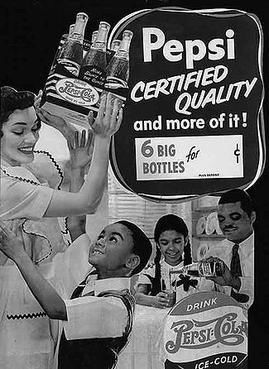Bias
How Business Has Undermined Racism: The Pepsi Story
Profit sometimes coincides with the promotion of human dignity
Posted February 3, 2019
Black History Month provides an opportune time to recall that American business sometimes labored right alongside the civil rights movement in undermining racism. Case in point: the Pepsi corporation’s efforts in the 1940s and 1950s to increase sales to blacks. Though focused foremost on profits, Pepsi’s “special markets” program fostered the business careers of a diverse group of black men, drew attention to the economic importance of what was then referred to as “the Negro market,” and projected a more progressive view of black life. Opposing racism turned out to be good for business.
Walter Mack, president of Pepsi during the 1940s, noticed that the company’s marketing strategies too often either ignored black customers or portrayed them in unflattering and stereotypical ways. Pepsi was struggling at the time and needed a strategy for increasing sales. The company had been portraying itself as a value leader, largely because its nickel bottles contained 12 ounces of soda, as compared to Coke’s 6 ounces. However, the lower per-ounce-cost led some to conclude that Pepsi was a lower-quality product, and the extra costs of production were eating into bottler’s margins.
Mack called for a team of black marketers to promote sales in black communities. The team was notable for its diversity. The first recruit, Hennan Smith, had worked in newspaper advertising. Later in the decade, other formidable recruits included Jean Emmons, who had been unable to find a suitable job despite holding an MBA from the University of Chicago, and Richard Hurt, who covered Jackie Robinson and the integration of blacks into major league baseball for a Harlem newspaper. Their charge? To enhance the relationship between black communities and the Pepsi-Cola corporation.
The team, which eventually numbered more than a dozen members, crisscrossed the USA, encountering racism at every turn. In the south, team members had no choice but to drink from “colored only” fountains, ride in the back of buses, and stay with families, because hotels refused to accommodate them. To avoid eating in segregated areas while traveling by train, they would sometimes take their meals in Pullman cars. They faced demeaning comments from fellow Pepsi employees and even threats from the Ku Klux Clan.
The work itself was long and hard. Team members often worked seven days a week. They paid visits to bottlers, civic organizations, churches, and business and professional meetings. Their message was unmistakable. The Coca Cola corporation was perceived as reluctant to hire blacks to play such roles, and its chair had endorsed the re-election campaign of a segregationist governor of Georgia. By contrast, visits by team members made it clear that Pepsi took a different stance on race and was actively courting the black community.
Instead of pandering to popular stereotypes, Pepsi promoted a different image of blacks in its advertising. The team persuaded popular entertainers such as Duke Ellington to endorse Pepsi. They featured profiles of prominent black citizens, such as Ralph Bunche, whose diplomacy had garnered him a Nobel Prize. Its ads depicted middle-class citizens who cared about their families, their jobs, and their communities, and who knew a good value when they saw one. One prominent print ad featured future US Secretary of Commerce Ron Brown as a child, reaching up for a bottle of Pepsi.

The effects were not immediate, but during the 1950s Pepsi’s sales increased dramatically, eventually outselling Coke in the black community by a margin of three to one. Years later, the technique would come to be known as “niche advertising,” an approach for carving out a distinct place in the market. More importantly, the biographical portraits and the like were so inspirational that teachers started using Pepsi ads in the classroom, awakening students’ imaginations to the types of lives they could lead.
Yet Pepsi’s focus on the black community was tempered by a determination not to offend its white customer base. Early in the 1950s, Mack left the company, which soon adopted a different marketing structure. The special markets team was disbanded, and many of its members were integrated into regional sales teams or left the company. One, Harvey Russell, remained with Pepsi and eventually rose to the position of vice president, becoming one of the first blacks to attain such a high position in a large American corporation.
The story of Pepsi’s special markets team is admirably told in Stephanie Capparell’s 2007 book, “The Real Pepsi Challenge.” Though motivated primarily by profit, Pepsi’s efforts to expand sales by focusing on the black community helped to show that blacks could perform at least as well as whites in a major corporation. It showed that corporations disregarded minority communities only at their own economic cost . And it showcased for all races a new and different image of the lives of blacks in American society. Sometimes good business and good social policy coincide.
References
Capparell, Stephanie. "The Real Pepsi Challenge." New York: Simon and Schuster, 2007.


